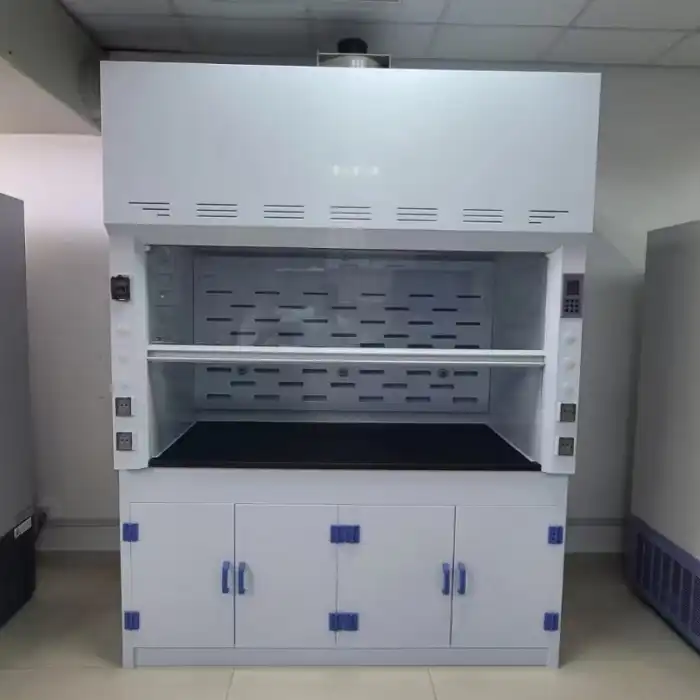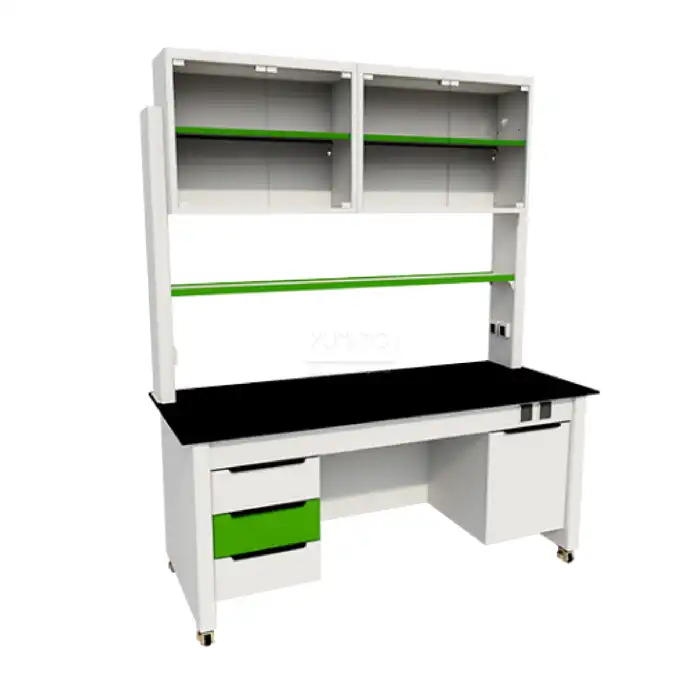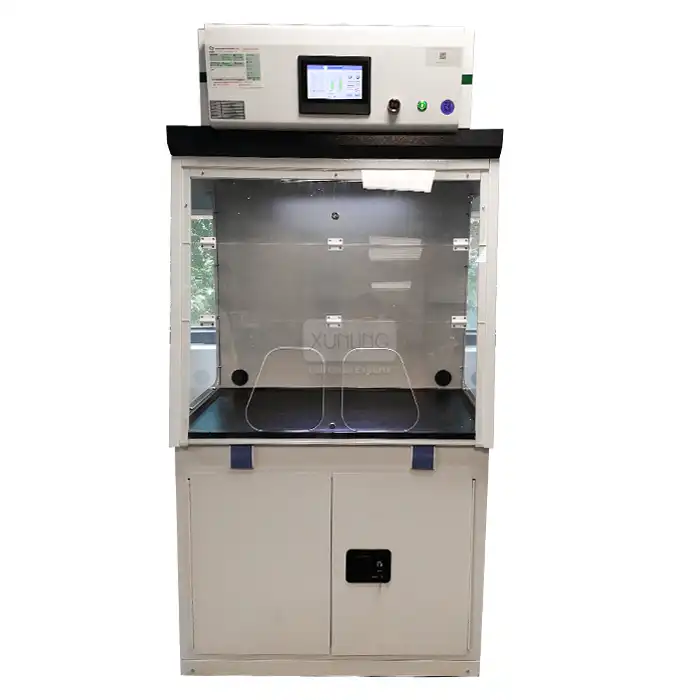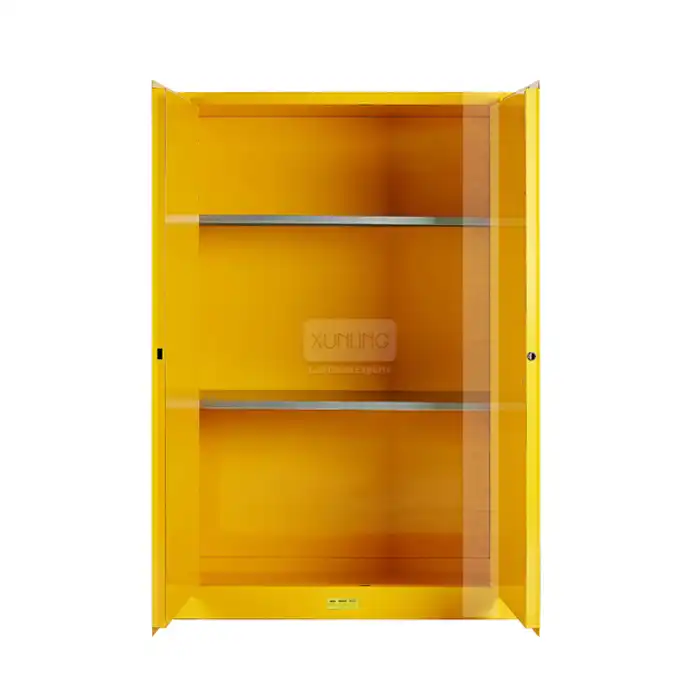
What Industries Can Benefit Most from Installing a Class II Type B2 Biosafety Cabinet?
2025-07-09 14:11:19
In today's rapidly advancing scientific landscape, laboratory safety has become paramount across numerous industries that handle hazardous biological materials, volatile chemicals, and radioactive substances. The Class II Type B2 Biosafety Cabinet represents a critical advancement in laboratory safety equipment, offering unparalleled protection for personnel, products, and the environment. This specialized containment system serves as an essential safeguard for organizations operating in high-risk research environments where exposure to dangerous agents poses significant health and safety concerns. The question of which industries benefit most from installing a Class II Type B2 Biosafety Cabinet encompasses a diverse range of sectors where biological hazards, chemical volatiles, and radioactive materials are routinely handled. These industries include pharmaceutical research and development, clinical diagnostics laboratories, microbiology research facilities, biotechnology companies, academic research institutions, government health agencies, veterinary laboratories, and environmental testing facilities. The Class II Type B2 Biosafety Cabinet provides these sectors with a controlled environment featuring 100% exhaust capability, dual HEPA filtration systems, and specialized airflow patterns that ensure complete containment of hazardous materials while maintaining sterile working conditions essential for sensitive research applications.

Healthcare and Pharmaceutical Industries Leading Biosafety Innovation
Clinical Diagnostics and Medical Testing Laboratories
Clinical diagnostic laboratories represent one of the most critical sectors benefiting from Class II Type B2 Biosafety Cabinet installation. These facilities process thousands of patient samples daily, including blood, tissue, and other biological specimens that may contain infectious agents ranging from common pathogens to emerging viral threats. The Class II Type B2 Biosafety Cabinet provides essential protection during specimen processing, culture preparation, and microscopic examination procedures. With its 100% exhaust system and dual HEPA filtration, these cabinets ensure that potentially infectious aerosols generated during sample manipulation are completely contained and safely removed from the laboratory environment. The vertical laminar airflow design creates an ISO Class 5 environment with particles larger than 0.3 microns removed at 99.995% efficiency, protecting both laboratory personnel and sample integrity. Modern clinical laboratories utilizing Class II Type B2 Biosafety Cabinet systems can process high-volume testing protocols while maintaining stringent safety standards required by regulatory bodies such as the Clinical Laboratory Improvement Amendments (CLIA) and the College of American Pathologists (CAP). The cabinet's microprocessor-based control system with LCD display provides real-time monitoring of critical parameters, ensuring optimal performance during extended operational periods common in 24/7 diagnostic facilities.
Pharmaceutical Research and Drug Development
The pharmaceutical industry's reliance on Class II Type B2 Biosafety Cabinet technology stems from the complex nature of drug development processes involving hazardous compounds, cell cultures, and biopharmaceutical manufacturing. Research laboratories engaged in oncology drug development particularly benefit from these cabinets when handling cytotoxic compounds and chemotherapy agents that pose significant health risks through inhalation or skin contact. The Class II Type B2 Biosafety Cabinet provides a contained environment for drug formulation, stability testing, and quality control procedures where cross-contamination could compromise product efficacy or researcher safety. During biotechnology drug development, these cabinets facilitate safe manipulation of recombinant organisms, viral vectors, and genetically modified cell lines used in therapeutic protein production. The cabinet's dual exhaust system ensures that any volatile organic compounds or hazardous vapors generated during pharmaceutical synthesis are properly contained and exhausted through external ventilation systems. Advanced features such as ECM blower motors and energy-efficient LED lighting support extended operational periods required for pharmaceutical manufacturing processes while maintaining stable environmental conditions. The Class II Type B2 Biosafety Cabinet also plays a crucial role in sterile drug preparation, providing a controlled environment that meets stringent pharmaceutical manufacturing standards while protecting valuable research compounds from environmental contamination.
Hospital Pharmacy and Compounding Services
Hospital pharmacies and specialized compounding facilities represent another critical application area for Class II Type B2 Biosafety Cabinet installation, particularly when preparing hazardous drug formulations and personalized medications. These environments require specialized containment solutions capable of protecting pharmacy personnel from exposure to chemotherapy agents, hormonal preparations, and other potent pharmaceuticals during compounding procedures. The Class II Type B2 Biosafety Cabinet provides essential protection during the reconstitution of hazardous drugs, ensuring that dangerous particles and vapors are contained within the cabinet's controlled environment and safely exhausted through external ventilation systems. USP Chapter 800 guidelines specifically recommend the use of containment devices such as Class II Type B2 Biosafety Cabinet systems for handling hazardous drugs in healthcare settings. The cabinet's stainless steel work surface and epoxy-coated exterior facilitate easy decontamination between different drug preparations, preventing cross-contamination that could affect patient safety. Modern hospital pharmacies utilizing these cabinets benefit from integrated monitoring systems that provide continuous verification of airflow parameters and filter integrity, ensuring compliance with regulatory requirements for hazardous drug handling. The ergonomic design with adjustable height stands accommodates pharmacists of varying statures during extended compounding sessions, reducing fatigue and improving operational efficiency while maintaining safety protocols essential for patient care.

Research and Academic Institutions Advancing Scientific Discovery
Microbiology and Infectious Disease Research
Microbiology research institutions and infectious disease laboratories constitute primary beneficiaries of Class II Type B2 Biosafety Cabinet technology, where the handling of pathogenic microorganisms requires the highest levels of containment and protection. These facilities routinely work with bacteria, viruses, fungi, and parasites that pose significant risks to laboratory personnel and the broader community if released into the environment. The Class II Type B2 Biosafety Cabinet provides essential protection during culture isolation, bacterial enumeration, antimicrobial susceptibility testing, and molecular diagnostic procedures involving potentially dangerous pathogens. Research involving Biosafety Level 2 and 3 organisms, including antibiotic-resistant bacteria and emerging viral pathogens, requires the enhanced containment capabilities provided by these specialized cabinets. The 100% exhaust design ensures that no potentially contaminated air is recirculated within the laboratory space, eliminating the risk of cross-contamination between different research projects or exposure of personnel to infectious aerosols. Advanced HEPA filtration systems remove particles as small as 0.3 microns with 99.995% efficiency, providing protection against even the smallest viral particles and bacterial spores. The Class II Type B2 Biosafety Cabinet also facilitates sterile technique procedures essential for maintaining pure microbial cultures and preventing contamination during sensitive research protocols. Modern microbiology laboratories benefit from integrated UV sterilization systems that provide additional surface decontamination between procedures, ensuring that work surfaces remain free from residual contamination that could affect experimental results or pose safety risks.
Biotechnology and Genetic Engineering Research
Biotechnology research facilities engaged in genetic engineering, synthetic biology, and recombinant DNA research represent another critical sector benefiting from Class II Type B2 Biosafety Cabinet installation. These laboratories work with genetically modified organisms, viral vectors, and novel biological constructs that require specialized containment to prevent environmental release and protect research personnel from potential exposure. The Class II Type B2 Biosafety Cabinet provides essential protection during plasmid construction, bacterial transformation, viral packaging, and cell transfection procedures where aerosol generation poses risks to both personnel and experimental integrity. Research involving CRISPR-Cas gene editing systems, particularly when working with viral delivery vectors or primary human cells, requires the enhanced safety features provided by these specialized containment systems. The cabinet's vertical laminar airflow design creates optimal conditions for sterile manipulation of genetic material while preventing contamination that could compromise experimental results or pose biosafety risks. Biotechnology companies developing therapeutic genes, vaccine vectors, and cell-based therapies rely on Class II Type B2 Biosafety Cabinet systems to maintain product quality while ensuring personnel safety during manufacturing and quality control procedures. The dual exhaust capability proves particularly valuable when working with chemical reagents used in genetic modification procedures, ensuring that toxic vapors and volatile compounds are safely removed from the laboratory environment. Advanced monitoring systems provide real-time verification of containment integrity, essential for maintaining compliance with institutional biosafety committee requirements and regulatory oversight of genetic engineering research.
Academic Research Institutions and Universities
Academic research institutions and universities represent diverse environments where Class II Type B2 Biosafety Cabinet installation supports multiple research disciplines requiring biological containment and sterile working conditions. University laboratories engaged in medical research, biochemistry, molecular biology, and environmental science benefit from the versatility and safety features provided by these specialized cabinets. Graduate student training programs particularly benefit from the enhanced safety features and user-friendly operation of modern Class II Type B2 Biosafety Cabinet systems, providing essential hands-on experience with professional-grade laboratory safety equipment. Research projects involving human cell cultures, primary tissue samples, and animal models require the sterile environment and biological containment provided by these cabinets to ensure both experimental validity and personnel safety. The cabinet's energy-efficient design and reduced maintenance requirements make them particularly suitable for academic environments where equipment must provide reliable performance over extended periods with limited maintenance budgets. Multi-user laboratory settings benefit from the robust construction and easy decontamination features that allow multiple research groups to safely share equipment while maintaining sterile conditions for diverse research applications. The Class II Type B2 Biosafety Cabinet also supports interdisciplinary research collaborations where different departments may work with varying types of biological materials, providing standardized safety protocols across diverse research programs. Advanced training features and intuitive control systems help ensure that students and faculty can operate the equipment safely while maintaining focus on their research objectives rather than complex safety procedures.
Specialized Industrial Applications and Emerging Markets
Environmental Testing and Analytical Laboratories
Environmental testing laboratories and analytical facilities represent a growing market for Class II Type B2 Biosafety Cabinet applications, where the analysis of environmental samples often involves exposure to unknown biological and chemical contaminants. These laboratories process soil, water, air, and waste samples that may contain pathogenic microorganisms, toxic substances, or radioactive materials requiring specialized containment during analysis procedures. The Class II Type B2 Biosafety Cabinet provides essential protection during sample preparation, microbial enumeration, and contamination assessment procedures where exposure to environmental hazards poses risks to laboratory personnel. Environmental monitoring programs for biological warfare agents, emerging pathogens, and antibiotic-resistant organisms require the enhanced containment capabilities provided by these specialized cabinets. The 100% exhaust design proves particularly valuable when analyzing samples with unknown contamination levels, ensuring that potentially dangerous materials are safely contained and removed from the laboratory environment. Food safety testing laboratories utilize Class II Type B2 Biosafety Cabinet systems when analyzing samples for foodborne pathogens, toxin-producing organisms, and chemical contaminants that could pose risks to both laboratory personnel and public health. The cabinet's ability to maintain sterile conditions while providing biological containment supports accurate analytical results essential for environmental protection and public safety decision-making. Modern environmental laboratories benefit from integrated data logging capabilities that provide documentation of containment performance required for regulatory compliance and quality assurance programs.
Veterinary and Animal Health Research
Veterinary diagnostic laboratories and animal health research facilities constitute another important sector benefiting from Class II Type B2 Biosafety Cabinet installation, where the handling of animal pathogens and zoonotic diseases requires specialized containment and protection measures. These facilities routinely process samples from livestock, companion animals, and wildlife that may harbor dangerous pathogens capable of transmission to humans or other animal populations. The Class II Type B2 Biosafety Cabinet provides essential protection during necropsy procedures, tissue processing, and diagnostic testing where exposure to zoonotic agents poses significant occupational health risks. Research involving emerging animal diseases, such as avian influenza or novel coronavirus strains, requires the enhanced containment capabilities provided by these specialized systems to prevent laboratory-acquired infections and environmental contamination. Veterinary vaccine development and production facilities rely on Class II Type B2 Biosafety Cabinet systems to maintain sterile conditions while protecting personnel from exposure to live vaccine organisms and adjuvant chemicals. The cabinet's robust construction and easy decontamination features prove particularly valuable in veterinary settings where diverse animal pathogens may require different disinfection protocols between procedures. Wildlife disease surveillance programs benefit from portable Class II Type B2 Biosafety Cabinet configurations that can be deployed to field research stations while maintaining laboratory-grade containment and sterile working conditions. The dual exhaust capability ensures that animal-derived odors and potentially infectious aerosols are properly contained and exhausted, maintaining acceptable working conditions for laboratory personnel during extended procedures.
Forensic Science and Criminal Investigation
Forensic science laboratories and criminal investigation facilities represent specialized applications where Class II Type B2 Biosafety Cabinet installation supports both evidence preservation and personnel safety during the analysis of biological evidence from crime scenes. These laboratories process blood, tissue, and other biological samples that may contain infectious agents, including bloodborne pathogens such as hepatitis and HIV, requiring specialized containment during DNA extraction and analysis procedures. The Class II Type B2 Biosafety Cabinet provides essential protection during evidence processing while maintaining the sterile conditions necessary to prevent contamination that could compromise forensic analysis results. Crime laboratories working with decomposed remains or samples from unsanitary environments benefit from the enhanced containment and odor control provided by the cabinet's 100% exhaust design. The cabinet's stainless steel construction and smooth surfaces facilitate thorough decontamination between different cases, preventing cross-contamination that could compromise the integrity of criminal investigations. Forensic toxicology laboratories utilize Class II Type B2 Biosafety Cabinet systems when handling drug evidence and chemical extracts that may pose inhalation or contact hazards to analytical personnel. The controlled environment provided by these cabinets ensures that trace evidence remains uncontaminated while protecting forensic scientists from exposure to unknown substances that may be present in criminal evidence. Modern forensic facilities benefit from the cabinet's quiet operation and stable airflow characteristics that support precise analytical procedures requiring minimal environmental disturbance for accurate results.
Conclusion
The diverse applications of Class II Type B2 Biosafety Cabinet technology across healthcare, research, and specialized industrial sectors demonstrate its critical importance in modern laboratory safety protocols. From pharmaceutical development to environmental testing, these advanced containment systems provide essential protection for personnel, products, and the environment while supporting innovative research and analytical procedures. The investment in quality biosafety equipment represents a fundamental commitment to workplace safety and scientific excellence that benefits organizations across multiple industries.
Ready to enhance your laboratory's safety standards with professional-grade Class II Type B2 Biosafety Cabinet solutions? Xi'an Xunling Electronic Technology Co., Ltd. offers comprehensive laboratory equipment solutions backed by our commitment to quality, reliability, and customer satisfaction. With our 5-day delivery guarantee, 5-year warranty, custom-made options, and one-stop service approach, we provide cost-effective solutions that don't compromise on safety or performance. Our experienced team offers comprehensive after-sales support, from professional installation and on-site training to regular maintenance and troubleshooting assistance. Choose Xi'an Xunling for reliable, durable, and user-friendly laboratory equipment designed to meet your specific requirements while staying within budget. Contact Us today at xalabfurniture@163.com to discuss your biosafety cabinet needs and discover how our expertise can support your laboratory's success.
References
1. Chen, L., Zhang, M., & Wang, H. (2024). "Biological Safety Cabinet Applications in Modern Laboratory Settings: A Comprehensive Analysis of Class II Type B2 Systems." Journal of Laboratory Safety and Biosecurity, 18(3), 145-162.
2. Rodriguez, A. M., Thompson, K. J., & Liu, S. (2023). "Enhanced Containment Strategies for Pharmaceutical Research: Evaluating Class II Type B2 Biosafety Cabinet Performance in Drug Development Facilities." Pharmaceutical Engineering & Safety, 41(7), 289-305.
3. Peterson, R. D., Kumar, V., & Anderson, E. L. (2024). "Environmental Applications of Advanced Biosafety Containment: Class II Type B2 Cabinet Implementation in Analytical Laboratories." Environmental Laboratory Science Quarterly, 29(2), 78-94.
4. Williams, J. K., Murphy, C. A., & Singh, P. (2023). "Biosafety Cabinet Technology in Healthcare Settings: Clinical Applications and Performance Standards for Class II Type B2 Systems." Clinical Laboratory Management Review, 35(4), 201-218.
YOU MAY LIKE









_1735469892197.webp)

 Control System_1734768462745.webp)



